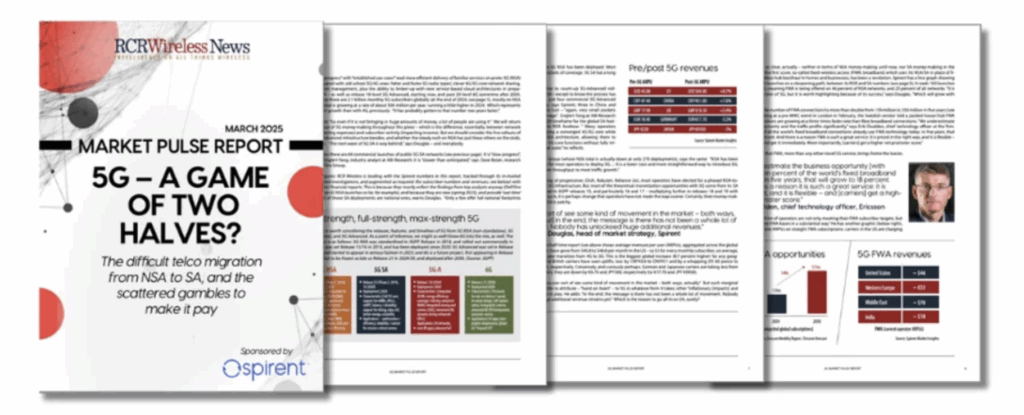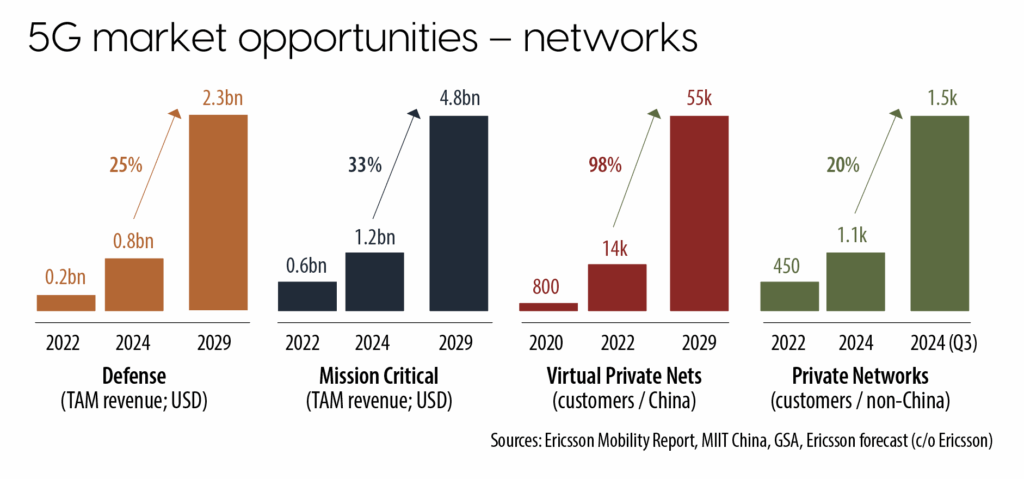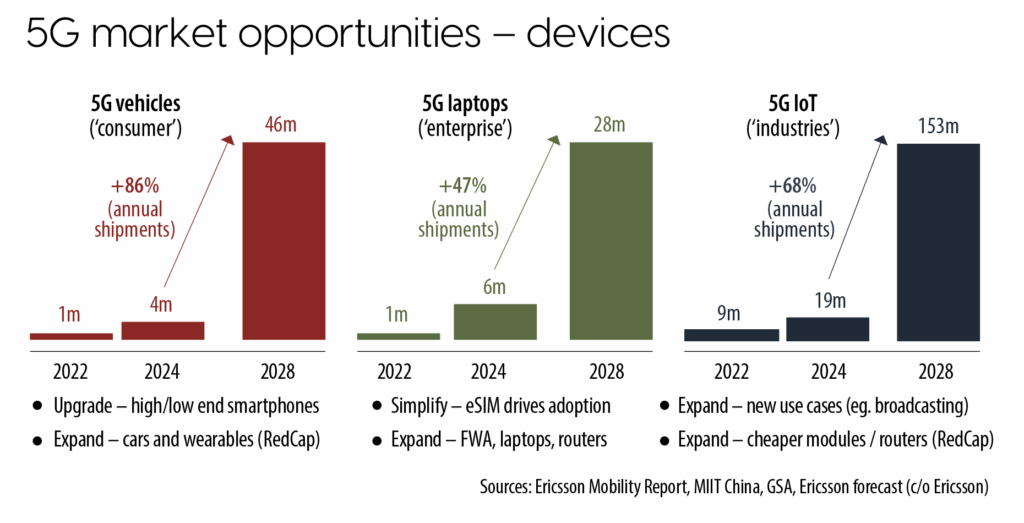5G progress hinges on enterprise demand, from protection to drones, whereas client breakthroughs lag. Operators should monetize APIs, gadgets, and networks quick — or threat lacking the true 5G alternative. Word, that is an excerpt from a brand new 5G Market Pulse report, out there to obtain totally free right here; the unique introduction and former entries have been printed on-line right here (intro) and right here (SA upgrades) and right here (FWA features) and right here (cash issues).
In sum – what to know
Enterprise drives progress – actual momentum with 5G will come from enterprise markets – protection, non-public networks, IoT, drones, and automotive, and never flashy client apps.
Client fizzles out – past mounted wi-fi and perhaps AR glasses, there’s little killer client demand; operators should rethink (take classes from enterprise departments).
APIs maintain promise – growing 5G community APIs might unlock massive enterprise worth, however challenges in monetization and developer adoption stay unresolved – in fact.
The reply (see earlier entry) from Ericsson in London is that new 5G progress – for operators and everyone – will come from FWA connections (rising 14 % per yr, from 159 million to 351 million in 2030; see web page 6 in report), and in any other case in new enterprise disciplines and enterprise markets.
Illustrations of those (see beneath) are as comply with: gross sales to the defence sector will develop at a compound annual charge (CAGR) of 25 % in worth phrases ($0.8 billion to $2.3 billion in 2029); gross sales of mission-critical 5G will develop at 33 % (CAGR; $1.2 billion to $4.8 billion in 2029); deployments of digital non-public 5G (in China) grew 98 % (CAGR; 14,000 in 2022 to 55,000 in 2024); deployments of straight non-public 5G (outdoors of China) grew at 20 % (CAGR; 1,100 in 2022 to 1,500 in 2024).
Ekudden feedback: “It won’t come collectively as a cell platform until we have now an end-to-end system. So the cloud half, the enterprise purposes, issues enormously. However equally, so does the readiness of the gadget ecosystem. Having 5G gadgets will enable us to scale the cell platform.” He exhibits a slide (see beneath) with high-growth shipments of gadgets within the client, enterprise, and industrial markets. Besides that Ericsson places vehicles (86 % CAGR; 4 million to 46 million in 2028) into the buyer bucket, laptops (47 % CAGR; six million to twenty-eight million) into the enterprise bucket, and non-specific ‘5G IoT’ gadgets (CAGR 56 %; 19 million to 153 million) into the economic one.
Unsure about you, however these all sound like enterprise gadgets.
An apart, and an admission of kinds: this feels (to this author) just a little alarming; 5 years’ protecting the non-public 5G area, about how the mobile trade is wanting outwards finally, and the operator neighborhood continues to be wanting inwards, scratching its head and choosing fluff from its belly-button. It’s harsh, but it surely sounds, primarily based on dialogue of the 5G SA function set in nationwide telcos, like they need to get extra critical about enterprises, and quick.
Douglas at Spirent says: “Sure, and even the deal with FWA blurs into the enterprise area – in multi-occupancy buildings (condominium blocks) and as network-backup in workplaces. Actually, the one [straight] consumer-focus is to carry primary AR to conventional spectacles – such as you and I put on.” We’re again right here, then – on the greatest client 5G alternative outdoors of FWA.
Ekudden references the success of Ray Ban’s line of (Meta-branded) good glasses. “They don’t seem to be but 5G related, however Ray Ban [sold] 1,000,000 such glasses final yr.” That is the “mass market [event]” referenced earlier.
Douglas explains: “It could enable some video and e-mail, some audio; it will likely be fairly optimum, however not very immersive. Will probably be tethered to a tool. That is without doubt one of the larger client apps; there are over two billion glasses-wearers worldwide. It may very well be a mass-adoption occasion – besides it’s 18-to-24 months out as a result of it will depend on the gadget ecosystem.” AR glasses (spectacles) made a critical look on stands at MWC in March.
However is that this actually it, the entire client 5G alternative – a wi-fi router and a pair of specs?
As a result of, as mentioned, the remaining is usually enterprise-geared, requiring deep perception and laborious yards, tied to the cultural and financial vagaries of all of the world’s completely different companies and industries. The exception, maybe, is V2X, however even that’s basically IoT-on-steroids, and a business-to-business case. Even so, it stands out: regulators are transferring to compel automakers to assist 5G-V2X to get NCAP five-star security scores on autos in sure markets (“China in 2026, India in 2027,” says Douglas). “Automobile makers are international, principally – so if it goes in there, it goes in in every single place. Lots of regulators are speaking about early dispensation in markets the place there isn’t essentially nationwide 5G protection but – so long as 5G is supported alongside motorway corridors,” he explains.
The purpose is V2X might “begin to cascade” – in time. So too might curiosity within the “low-altitude drone economic system” – which appears a surer wager, in income phrases, than hyped direct-to-device satellite tv for pc comms. Douglas says of the latter: “It’s nice, and it’ll occur, but it surely in all probability received’t make some huge cash; perhaps an additional greenback a month on a premium package deal, however that’s about it.” Against this, if the regulatory problem with past visible line-of-sight (BVLOS) monitoring of low-altitude drone flights, typically out of attain of satellite tv for pc protection, could be negated with new ground-level 5G RAN triangulation, then there may very well be a “huge alternative for public security, fleet logistics, and the navy”.
Huawei has launched ‘tilt antennas’ in China to trace drones “one hundred pc with out GNSS”, he says. Or with satellite tv for pc backup, not less than. “Lots of operators are fairly ; it may very well be fairly profitable,” he provides, acknowledging that Nokia’s work with Swisscom in Switzerland and Citymesh in Belgium to stand-up blue-light drone companies on 5G have caught the creativeness of the worldwide service market. In the meantime, SA-based community APIs, to be mentioned on the principle levels at MWC in Barcelona (once more), seem like a intelligent concession and not using a clear utility, nor enough curiosity from builders. Douglas feedback: “We’re just a little sceptical. There’s loads of curiosity to check the API framework however not present APIs, if that is sensible. So very primary APIs which are launched right this moment, like for SIM swaps, are usually not being examined. And that’s perhaps as a result of there’s not loads of demand but.”
This was replayed to a Vonage exec on the Ericsson showcase in London in early February, who snorted on the thought, and mentioned SIM-swaps are well-established in main monetary companies, and a few massive nationwide carriers. However Douglas says the one demand from operators to check community APIs is to reveal extra superior SA options like voice, site visitors steering, and enhanced positioning. “And once more, that’s all for enterprises, and never for shoppers – and once more, it’s a few years out,” he says, earlier than returning to the (non-public) shock-and-horror that client 5G is a lifeless rubber. “So sure, the remainder of it’s actually about enterprises, and there’s no killer app. All of the operators wish to stack a lot of completely different companies to create incremental income from 5G.”
Englert-Yang says the identical, but additionally seeks to elucidate the logic and jeopardy for carriers. “5G APIs are nonetheless in early improvement – with a lot of uncertainties and little short-term income expectation. There are historic challenges with community APIs to achieve traction with builders, which operators and distributors are reliant on. It stays to be seen whether or not present makes an attempt will succeed.” He references Ericsson’s three way partnership on 5G APIs (Aduna) with a bunch of worldwide operators, and Nokia’s acquisition of US startup agency Speedy’s API developer hub to go together with its community as-a-code platform. “We’re watching to see which technique pays off. There are excessive income expectations for community APIs four-to-five years from now, which is why distributors are making these investments.”

Even so, nearer-term income alternatives with 5G SA and 5G Superior are fuzzy – and albeit underwhelming. As if the sunshine on the finish of the tunnel is likely to be the sunshine of an oncoming prepare. “The transition to 5G SA awaits clearer monetization methods,” displays Englert-Yang. Regionally, carriers in Asia Pacific and North America are main the way in which – for rollouts, if not for revenues. “China is essentially the most mature market. High operators in North America have native implementations, however are usually not at industrial scale. Turkey, Germany, and Spain are [also] advancing 5G SA capabilities.” However key points are unresolved, he says: 4G migration methods, RAN “funding strains”, SA function improvement (“slicing and APIs”), and cloud automation of each the infrastructure- and application-layers.
Tons to think about, then – because the whistle blows for the second half. However are we lacking the purpose? If the brand new SA-version of 5G, simply off the coaching pitch, is full-strength 5G, and 5G-Superior, simply out of the academy, is max-strength 5G, is it even half time but? As a result of, for industrial 5G-proper networks, the match has solely simply began. Greater than this, the entire level with 5G – which makes it extra transformative than earlier generational 3GPP upgrades, even and not using a clear income endgame – is that it creates a platform-based enterprise mannequin and expertise stack, on high of which operators can riff anyway they need. They only should get there first – which is the entire digital-change recreation, and justification of the NSA self-discipline over the past 5 years to an extent.


